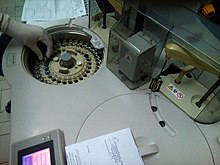
Back كيمياء سريرية Arabic Klinička hemija BS Química clínica Catalan Klinische Chemie German Klinika kemio Esperanto Química clínica Spanish شیمی بالینی Persian Kliininen kemia Finnish Chimie clinique French Kimia klinik ID
This article relies largely or entirely on a single source. (September 2020) |

Clinical chemistry (also known as chemical pathology, clinical biochemistry or medical biochemistry) is a division in medical laboratory sciences focusing on qualitative tests of important compounds, referred to as analytes or markers, in bodily fluids and tissues using analytical techniques and specialized instruments.[1] This interdisciplinary field includes knowledge from medicine, biology, chemistry, biomedical engineering, informatics, and an applied form of biochemistry (not to be confused with medicinal chemistry, which involves basic research for drug development).[citation needed]
The discipline originated in the late 19th century with the use of simple chemical reaction tests for various components of blood and urine. In the many decades since, clinical chemists use automated analyzer in many clinical laboratories, which does experimental techniques ranging from pipetting specimens and specimen labelling to advanced measurement techniques such as spectrometry, chromatography, photometry, potentiometry, etc.[2] These instruments provide different results that help identify uncommon analytes, changes in light and electronic voltage properties of naturally-occurring analytes such as enzymes, ions, electrolytes, and their concentrations, all of which are important for diagnosing diseases.
Blood and urine are the most common test specimens clinical chemists or medical laboratory scientists collect for clinical routine tests, with a main focus on serum and plasma in blood.[3] There are now many blood tests and clinical urine tests with extensive diagnostic capabilities. Some clinical tests require clinical chemists to process the specimen before testing. Clinical chemists and medical laboratory scientists serve as the interface between the laboratory side and the clinical practice, providing suggestions to physicians on which test panel to order and interpret any irregularities in test results that reflect on the patient's health status and organ system functionality.[4] This allows healthcare providers to make more accurate evaluation of a patient's health and to diagnose disease, predicting the progression of a disease (prognosis), screening, and monitoring the treatment's efficiency in a timely manner. The type of test required dictates what type of sample is used.
- ^ Bishop, Michael L.; Fody, Edward P.; Schoeff, Fody (2020). Clinical Chemistry: Principles, Techniques, Correlations. Enhanced Edition (8th ed.). Burlington: Jones & Bartlett Learning. pp. 76–77. ISBN 9781284510140.
- ^ Burtis, Carl A.; Bruns, David E. (2014). Tietz Fundamentals of Clinical Chemistry and Molecular Diagnostics (7th ed.). Missouri: Elsevier. pp. 674–709. ISBN 978-1-4557-4165-6.
- ^ Science, Mayo Clinic College of Medicine and. "Medical Laboratory Scientist - Explore Health Care Careers - Mayo Clinic College of Medicine & Science". Mayo Clinic College of Medicine and Science. Retrieved 2023-04-02.
- ^ Abisti, Gerard Evans. "Chemical Pathology". The Association of Clinical Pathologists. Retrieved 2023-03-31.
© MMXXIII Rich X Search. We shall prevail. All rights reserved. Rich X Search